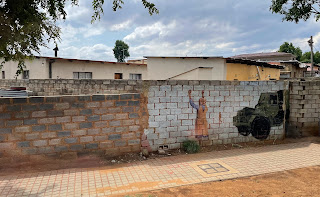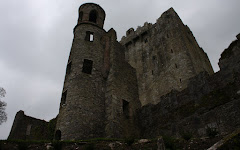Can you identify the whereabouts of any of these photos?
Thursday, December 30, 2021
On the Run in October: Places You May Have Heard Of
Well,...Photo #1 is in Pretoria, Photo #2 is in Johannesburg, and Photo #3 is in Soweto. Of course these are only snapshots of a specific time and location, compassed within a much more expansive scope and setting. In fact, while in S. Africa, we really only had a glimpse of each of them, yet each left an imprint on my memory. I think on these places and recount in my mind the impressions and experiences that became mine for having spent a wee bit of time within those spaces.
Pretoria I first heard mention of as a child: My mom would sing "Marching to Pretoria." (Actually, I think my mom liked marches because several childhood memories include soundtracks of various marches she introduced to her children.) Because I asked her then where Pretoria was, I've long known it was in S. Africa, but I really have not known the history of the song until I looked it up after my return from the trip. Apparently, during S. Africa's Boer Wars both sides sang some version of the song, although language (Afrikaans or English), content, and even the tune varied. In the 1960s, the song became popular in the USA as a "folk song"--probably how my mom learned it--even if in truth its roots are more like an "imperialist song."
One of three capital cities, the one housing the executive branch of government and the one hosting foreign embassies, Pretoria is also famous for streets lined with jacaranda. And I will just confess right now how bewitched I am by jacaranda all arrayed in its purple springtime glory, and how in 2021 I witnessed TWO jacaranda springtimes--one in Hawai (Northern Hemisphere) and one in S. Africa (Southern Hemisphere). So do note how most of my photos of Pretoria incorporate jacaranda:
Although we stayed two nights at the Marriott in the Melrose Arch Precinct of Johannesburg, we never really had the chance to experience the city other than the area adjacent to our hotel--with all the security and all the upscale style of the Melrose Arch Precinct in play--and a cursory bus tour. Someday I would like to be able to explore the city in greater depth and detail. The nighttime photo above, my only photo of Johannesburg, I took near where we had dinner our first night there.
Our tour and visit in Soweto, originally a black township bordering Johannesburg but now incorporated within the municipality of Johannesburg itself, had the most impact for me. In fact, Soweto ranks high on my most memorable experiences of the entire trip.
Both Nelson Mandela and Desmond Tutu owned homes in Soweto. Desmond Tutu was living in Cape Town at the time of our visit, and our guide reported that a son currently lived in the home in Soweto. Mandela lived in his Soweto house from 1946-1962, although when he became a committed freedom fighter (circa 1958) he seldom stayed there--the "Black Pimpernel" always on the run. After Mandela's imprisonment beginning in 1962, his second wife Winnie continued to live in the home with her two daughters. Today it is a museum.
The Soweto uprising of 1976, a series of demonstrations and protests led by black school children, catalyzed international awareness of apartheid and intensified the scrutiny of that system and its practices. On the morning of June 16, 1976, students from various schools in Soweto began to protest in the streets in response to a decree instituting Afrikaans as an official language of instruction in black schools.The association of Afrikaans with apartheid--"the language of the oppressor," as Desmond Tutu stated--had motivated black S. Africans to prefer English and indigenous African languages as official languages. The decree to officially change the languages of instruction in black schools to English and Afrikaans sought to reverse the ever declining use of Afrikaans by black S. Africans. Around 10,000 students left their schools that morning, many of them unaware of the protest until that morning but who agreed to participate in a peaceful protest against the decree. Antoinette and Hector Pietersen were two of those students although 16-year-old Antoinette had no idea that her 12-year-old brother Hector would be there also. The students sang and waved placards with statements like "Down with Afrikaans" and "If we must do Afrikaans, Vorster must do Zulu." At first police tried to deter the students with tear gas and warning shots. Then police fired directly into the crowd of demonstrators. Among the first students shot dead were 15-year-old Hastings Ndlovu and Antoinette's brother Hector Pietersen. Sam Nzima took a photograph of a dying Hector as he was carried away by Mbuyisa Makhubu and accompanied by his sister Antoinette.
A photograph that rocked the world. Time Magazine listed it as one of the 100 most influential images of all time.
Violence escalated and clinics were swamped with injured and bloody children. Police requested a list of all patients with bullet wounds so that they could be prosecuted for rioting but doctors refused to create such a list, recording bullet wounds as abscesses.
Here is Antoinette Sithole (Pietersen) today. She works at the Hector Pietersen Museum, located about two blocks away from where her brother was killed. She spoke with us, sharing her story, her memories, and her thoughts--about then and for what lies ahead.
I had the opportunity to speak with Antoinette for a moment, and a lump still rises in my throat when I remember. No thoughts of retribution ever, she told me; retribution fixes nothing.
Thanks to Don Louw, our tour guide, for this image.
Subscribe to:
Post Comments (Atom)














































No comments:
Post a Comment